

:
Comprehensive rehabilitation patient care is a holistic approach that aims to restore and enhance the physical, cognitive, emotional, and social well-being of individuals recovering from illness, injury, or surgery. This article explores the key strategies involved in providing comprehensive rehabilitation patient care, focusing on the integration of multidisciplinary teams, personalized treatment plans, patient-centered care, evidence-based practices, and the importance of ongoing support and education.
1. Multidisciplinary Team Approach:
A crucial aspect of comprehensive rehabilitation patient care is the integration of a multidisciplinary team consisting of healthcare professionals from various disciplines. These may include physicians, nurses, physical therapists, occupational therapists, speech-language pathologists, psychologists, social workers, and other specialists depending on the specific needs of the patient. The collaboration of these professionals ensures a comprehensive evaluation, treatment, and ongoing care plan for each patient, addressing all aspects of their recovery journey.
2. Personalized Treatment Plans:
Comprehensive rehabilitation patient care requires individualized treatment plans tailored to the specific needs, goals, and preferences of each patient. The multidisciplinary team conducts a thorough assessment, including medical history, physical examination, functional abilities, and psychosocial factors, to develop a personalized plan that optimizes the patient’s recovery. This plan may include a combination of therapies, exercises, medication management, assistive devices, and lifestyle modifications to address physical, cognitive, emotional, and social challenges.
3. Patient-Centered Care:
Patient-centered care is a fundamental principle in comprehensive rehabilitation. It involves actively involving patients in their care decisions, respecting their values and preferences, and fostering a collaborative and empowering relationship between the healthcare team and the patient. Effective communication, shared decision-making, and regular feedback from the patient are essential in ensuring that the treatment plan aligns with their goals and promotes their active participation in the recovery process.
4. Evidence-Based Practices:
In comprehensive rehabilitation patient care, evidence-based practices form the foundation of treatment approaches. Healthcare professionals rely on the latest research, clinical guidelines, and best practices to inform their decision-making and provide interventions that have proven effectiveness. Evidence-based practices ensure that patients receive the most appropriate and beneficial care, resulting in improved outcomes and maximizing the potential for recovery.
5. Continuity of Care:
Comprehensive rehabilitation patient care encompasses not only the acute phase of recovery but also the transition to the community and ongoing support. Continuity of care involves seamless coordination and communication between different healthcare settings, such as hospitals, rehabilitation centers, outpatient clinics, and community resources. This includes providing clear discharge instructions, facilitating access to follow-up appointments, coordinating home healthcare services, and collaborating with primary care providers to ensure a smooth transition and ongoing support for the patient’s long-term well-being.
6. Psychosocial Support:
Comprehensive rehabilitation patient care recognizes the impact of psychosocial factors on recovery and well-being. It involves addressing the emotional, social, and psychological needs of patients and their families. This may include individual or group counseling, support groups, stress management techniques, and family education. Psychosocial support aims to enhance coping skills, reduce anxiety and depression, promote resilience, and improve overall quality of life during the rehabilitation process.
7. Education and Self-Management:
Empowering patients with knowledge and self-management skills is a key component of comprehensive rehabilitation patient care. Healthcare professionals provide education on the nature of their condition, treatment options, potential challenges, and strategies for self-care and self-monitoring. This includes educating patients on proper medication management, healthy lifestyle choices, adaptive techniques, and strategies for preventing further injury or relapse. By equipping patients with the necessary knowledge and skills, they can actively participate in their recovery and maintain their gains beyond the formal rehabilitation program.
8. Ongoing Monitoring and Evaluation:
Comprehensive rehabilitation patient care involvesongoing monitoring and evaluation of the patient’s progress to ensure that the treatment plan remains effective and appropriate. This includes regular assessments of functional abilities, pain levels, cognitive function, emotional well-being, and social integration. The multidisciplinary team collaborates to adjust the treatment plan as needed, address any barriers or challenges that may arise, and set new goals to continue supporting the patient’s recovery.
9. Integration of Technology:
In today’s digital age, the integration of technology has become increasingly important in comprehensive rehabilitation patient care. Various technological tools and devices can enhance the effectiveness and efficiency of treatment. For example, wearable sensors can track movement and provide feedback on exercise adherence and progress. Telemedicine and remote monitoring can enable remote consultations and follow-ups, particularly for patients in rural or underserved areas. Virtual reality and augmented reality technologies can be used for immersive and engaging therapy sessions. The integration of technology can expand access to care, improve patient engagement, and provide additional support and resources.
10. Family and Caregiver Involvement:
Comprehensive rehabilitation patient care recognizes the importance of involving family members and caregivers in the treatment process. They play a vital role in providing support, assisting with activities of daily living, and promoting the patient’s overall well-being. Healthcare professionals provide education and training to family members and caregivers on how to best support the patient’s recovery, manage any ongoing challenges, and facilitate a safe and supportive environment at home. Regular communication and collaboration with family members ensure that they are equipped with the knowledge and resources to play an active role in the patient’s care.
Conclusion:
Comprehensive rehabilitation patient care requires a multifaceted approach that addresses the physical, cognitive, emotional, and social aspects of recovery. By embracing a multidisciplinary team approach, personalizing treatment plans, prioritizing patient-centered care, employing evidence-based practices, ensuring continuity of care, providing psychosocial support, emphasizing education and self-management, monitoring and evaluating progress, integrating technology, and involving family and caregivers, healthcare professionals can deliver comprehensive rehabilitation care that optimizes patient outcomes and improves their overall quality of life. By implementing these key strategies, individuals undergoing rehabilitation can achieve their full potential and regain independence and well-being.
